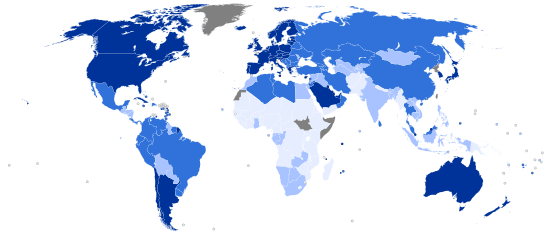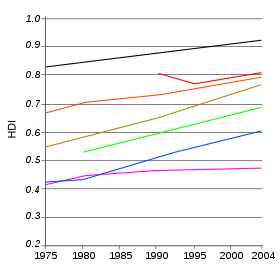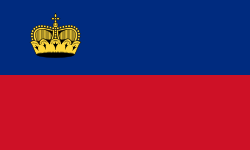Human Development Index

The Human Development Index (HDI) is a composite statistic of life expectancy, education, and per capita income indicators, which is used to rank countries into four tiers of human development. It was created by Indian economist Amartya Sen and Pakistani economist Mahbub ul Haq in 1990[1] and was published by the United Nations Development Programme.[2]
The 2010 Human Development Report introduced an Inequality-adjusted Human Development Index (IHDI). While the simple HDI remains useful, it stated that "the IHDI is the actual level of human development (accounting for inequality)," and "the HDI can be viewed as an index of 'potential' human development (or the maximum IHDI that could be achieved if there were no inequality)."[3]
Origins


The origins of the HDI are found in the annual Development Reports of the United Nations Development Programme (UNDP). These were devised and launched by Pakistani economist Mahbub ul Haq in 1990 and had the explicit purpose "to shift the focus of development economics from national income accounting to people-centred policies". To produce the Human Development Reports, Mahbub ul Haq brought together a group of development economists including Paul Streeten, Frances Stewart, Gustav Ranis, Keith Griffin, Sudhir Anand and Meghnad Desai. Working along with Nobel laureate Amartya Sen, they worked on capabilities and functionings that provided the underlying conceptual framework. Haq was sure that a simple composite measure of human development was needed in order to convince the public, academics, and policy-makers that they can and should evaluate development not only by economic advances but also improvements in human well-being. Sen initially opposed this idea, but he soon went on to help Haq develop the Index in the future. Sen was worried that it was going to be difficult to capture the full complexity of human capabilities in a single index but Haq persuaded him that only a single number would shift the attention of policy-makers from concentration on economic to human well-being.[4][5]
Dimensions and calculation
New method (2010 Report onwards)
Published on 4 November 2010 (and updated on 10 June 2011), starting with the 2010 Human Development Report the HDI combines three dimensions:[6]
- A long and healthy life: Life expectancy at birth
- Education index: Mean years of schooling and Expected years of schooling
- A decent standard of living: GNI per capita (PPP US$)
In its 2010 Human Development Report, the UNDP began using a new method of calculating the HDI. The following three indices are used:
1. Life Expectancy Index (LEI) 
2. Education Index (EI) 
- 2.1 Mean Years of Schooling Index (MYSI)
 [7]
[7]
- 2.2 Expected Years of Schooling Index (EYSI)
 [8]
[8]
3. Income Index (II) 
Finally, the HDI is the geometric mean of the previous three normalized indices:
![\textrm{HDI} = \sqrt[3]{\textrm{LEI}\cdot \textrm{EI} \cdot \textrm{II}}.](../I/m/3cb520e370fb8d0c25edd0e5a1731218.png)
LE: Life expectancy at birth
MYS: Mean years of schooling (Years that a 25-year-old person or older has spent in schools)
EYS: Expected years of schooling (Years that a 5-year-old child will spend with his education in his whole life)
GNIpc: Gross national income at purchasing power parity per capita
Old method (before 2010 Report)
The HDI combined three dimensions last used in its 2009 Report:
- Life expectancy at birth, as an index of population health and longevity
- Knowledge and education, as measured by the adult literacy rate (with two-thirds weighting) and the combined primary, secondary, and tertiary gross enrollment ratio (with one-third weighting).
- Standard of living, as indicated by the natural logarithm of gross domestic product per capita at purchasing power parity.

|
Arab States
|
This is the methodology used by the UNDP up until its 2011 report.
The formula defining the HDI is promulgated by the United Nations Development Programme (UNDP).[9] In general, to transform a raw variable, say  , into a unit-free index between 0 and 1 (which allows different indices to be added together), the following formula is used:
, into a unit-free index between 0 and 1 (which allows different indices to be added together), the following formula is used:
where  and
and  are the lowest and highest values the variable
are the lowest and highest values the variable  can attain, respectively.
can attain, respectively.
The Human Development Index (HDI) then represents the uniformly weighted sum with ⅓ contributed by each of the following factor indices:
- Life Expectancy Index =

- Education Index =

- Adult Literacy Index (ALI) =

- Gross Enrollment Index (GEI) =

- Adult Literacy Index (ALI) =
- GDP =

Other organizations/companies may include other factors, such as infant mortality, which produces different number of HDI.
2014 report
The 2014 Human Development Report by the United Nations Development Program was released on July 24, 2014, and calculates HDI values based on estimates for 2013. Below is the list of the "very high human development" countries:[10]
-
 = increase.
= increase. -
 = steady.
= steady. -
 = decrease.
= decrease. - The number in brackets represents the number of ranks the country has climbed (up or down) relative to the ranking in 2013 report.
| Rank | Country | HDI | ||
|---|---|---|---|---|
| New 2014 estimates for 2013 [11] |
Change in rank between 2014 report to 2013 report[11] | New 2014 estimates for 2013 [11] |
Change compared between 2014 report and 2013 report [11] | |
| 1 | | | 0.944 | |
| 2 | | | 0.933 | |
| 3 | | | 0.917 | |
| 4 | | | 0.915 | |
| 5 | | | 0.914 | |
| 6 | | | 0.911 | |
| 7 | | | 0.910 | |
| 8 | | | 0.902 | |
| 9 | | | 0.901 | |
| 10 | | | 0.900 | |
| 11 | | | 0.899 | |
| 12 | | | 0.898 | |
| 13 | | | 0.895 | |
| 14 | | | 0.892 | |
| 15 | | | 0.891 | |
| 15 | | | 0.891 | |
| 17 | | | 0.890 | |
| 18 | | | 0.889 | |
| 19 | | | 0.888 | |
| 20 | | | 0.884 | |
| 21 | | | 0.881 | |
| 21 | | | 0.881 | |
| 21 | | | 0.881 | |
| 24 | | | 0.879 | |
| 25 | | | 0.874 | |
| 26 | | | 0.872 | |
| 27 | | | 0.869 | |
| 28 | | | 0.861 | |
| 29 | | | 0.853 | |
| 30 | | | 0.852 | |
| 31 | | | 0.851 | |
| 32 | | | 0.845 | |
| 33 | | | 0.840 | |
| 34 | | | 0.836 | |
| 35 | | | 0.834 | |
| 35 | | | 0.834 | |
| 37 | | | 0.830 | |
| 37 | | | 0.830 | |
| 39 | | | 0.829 | |
| 40 | | | 0.827 | |
| 41 | | | 0.822 | |
| 41 | | | 0.822 | |
| 43 | | | 0.818 | |
| 44 | | | 0.815 | |
| 44 | | | 0.815 | |
| 46 | | | 0.814 | |
| 47 | | | 0.812 | |
| 48 | | | 0.810 | |
| 49 | | | 0.808 | |
Inequality-adjusted HDI
The Inequality-adjusted Human Development Index (IHDI)[10] is a "measure of the average level of human development of people in a society once inequality is taken into account."
Note: The green arrows (![]() ), red arrows (
), red arrows (![]() ), and blue dashes (
), and blue dashes (![]() ) represent changes in rank. The changes in rank are not relative to the HDI list above, but are according to the source (p. 168) calculated with the exclusion of countries which are missing IHDI data.
) represent changes in rank. The changes in rank are not relative to the HDI list above, but are according to the source (p. 168) calculated with the exclusion of countries which are missing IHDI data.
-
 Norway 0.891 (
Norway 0.891 ( )
) -
 Australia 0.860 (
Australia 0.860 ( )
) -
 Netherlands 0.854 (
Netherlands 0.854 ( 1)
1) -
 Switzerland 0.847 (
Switzerland 0.847 ( 3)
3) -
 Germany 0.846 (
Germany 0.846 ( )
) -
 Iceland 0.843 (
Iceland 0.843 ( 2)
2) -
 Sweden 0.840 (
Sweden 0.840 ( 4)
4) -
 Denmark 0.838 (
Denmark 0.838 ( 1)
1) -
 Canada 0.833 (
Canada 0.833 ( 4)
4) -
 Ireland 0.832 (
Ireland 0.832 ( 4)
4) -
 Finland 0.830 (
Finland 0.830 ( )
) -
 Slovenia 0.824 (
Slovenia 0.824 ( 2)
2) -
 Austria 0.818 (
Austria 0.818 ( 1)
1) -
 Luxembourg 0.814 (
Luxembourg 0.814 ( 3)
3) -
 Czech Republic 0.813 (
Czech Republic 0.813 ( 1)
1) -
 United Kingdom 0.812 (
United Kingdom 0.812 ( 3)
3) -
.svg.png) Belgium 0.806 (
Belgium 0.806 ( 2)
2) -
 France 0.804 (
France 0.804 ( )
) -
 Japan 0.799 (New)
Japan 0.799 (New) -
 Israel 0.793 (
Israel 0.793 ( 1)
1) -
 Slovakia 0.778 (
Slovakia 0.778 ( 1)
1) -
 Spain 0.775 (
Spain 0.775 ( 2)
2) -
 Italy 0.768 (
Italy 0.768 ( 1)
1) -
 Estonia 0.767 (
Estonia 0.767 ( 1)
1) -
 Greece 0.762 (
Greece 0.762 ( 2)
2) -
 Malta 0.760 (
Malta 0.760 ( 3)
3) -
 Hungary 0.757 (
Hungary 0.757 ( 1)
1) -
 United States 0.755 (
United States 0.755 ( 12)
12) -
 Poland 0.751 (
Poland 0.751 ( 1)
1) -
 Cyprus 0.752 (
Cyprus 0.752 ( 1)
1) -
 Lithuania 0.746 (
Lithuania 0.746 ( 2)
2) -
 Portugal 0.739 (
Portugal 0.739 ( )
) -
 South Korea 0.736 (
South Korea 0.736 ( 5)
5) -
 Latvia 0.725 (
Latvia 0.725 ( 1)
1) -
 Croatia 0.721 (
Croatia 0.721 ( 4)
4) -
 Argentina 0.680 (
Argentina 0.680 ( 7)
7) -
 Chile 0.661 (
Chile 0.661 ( 4)
4)
Countries in the top quartile of HDI ("very high human development" group) with a missing IHDI: New Zealand, Singapore, Hong Kong, Liechtenstein, Brunei, Qatar, Saudi Arabia, Andorra, United Arab Emirates, Bahrain, Cuba, and Kuwait.
Countries not included
Some countries were not included for various reasons, mainly the unavailability of certain crucial data. The following United Nations Member States were not included in the 2014 report:[10] North Korea, Marshall Islands, Monaco, Nauru, San Marino, Somalia, South Sudan, and Tuvalu.
2013 report
The 2013 Human Development Report by the United Nations Development Program was released on March 14, 2013, and calculates HDI values based on estimates for 2012. Below is the list of the "very high human development" countries:[12]
Note: The green arrows (![]() ), red arrows (
), red arrows (![]() ), and blue dashes (
), and blue dashes (![]() ) represent changes in rank when compared to the new 2012 data HDI for 2011 – published in the 2012 report.
) represent changes in rank when compared to the new 2012 data HDI for 2011 – published in the 2012 report.
-
 Norway 0.955 (
Norway 0.955 ( )
) -
 Australia 0.938 (
Australia 0.938 ( )
) -
 United States 0.937 (
United States 0.937 ( 1)
1) -
 Netherlands 0.921 (
Netherlands 0.921 ( 1)
1) -
 Germany 0.920 (
Germany 0.920 ( 4)
4) -
 New Zealand 0.919 (
New Zealand 0.919 ( 1)
1) -
 Ireland 0.916 (
Ireland 0.916 ( )
) -
 Sweden 0.916 (
Sweden 0.916 ( 3)
3) -
 Switzerland 0.913 (
Switzerland 0.913 ( 2)
2) -
 Japan 0.912 (
Japan 0.912 ( 2)
2) -
 Canada 0.911 (
Canada 0.911 ( 5)
5) -
 South Korea 0.909 (
South Korea 0.909 ( 3)
3) -
 Hong Kong 0.906 (
Hong Kong 0.906 ( )
) -
 Iceland 0.906 (
Iceland 0.906 ( )
) -
 Denmark 0.901 (
Denmark 0.901 ( 1)
1) -
 Israel 0.900 (
Israel 0.900 ( 1)
1) -
.svg.png) Belgium 0.897 (
Belgium 0.897 ( 1)
1) -
 Austria 0.895 (
Austria 0.895 ( 1)
1) -
 Singapore 0.895 (
Singapore 0.895 ( 7)
7) -
 France 0.893 (
France 0.893 ( )
) -
 Finland 0.892 (
Finland 0.892 ( 1)
1) -
 Slovenia 0.892 (
Slovenia 0.892 ( 1)
1) -
 Spain 0.885 (
Spain 0.885 ( )
) -
 Liechtenstein 0.883 (
Liechtenstein 0.883 ( 16)
16) -
 Italy 0.881 (
Italy 0.881 ( 1)
1) -
 Luxembourg 0.875 (
Luxembourg 0.875 ( 1)
1) -
 United Kingdom 0.875 (
United Kingdom 0.875 ( 1)
1) -
 Czech Republic 0.873 (
Czech Republic 0.873 ( 1)
1) -
 Greece 0.860 (
Greece 0.860 ( )
) -
 Brunei 0.855 (
Brunei 0.855 ( 1)
1) -
 Cyprus 0.848 (
Cyprus 0.848 ( 1)
1) -
 Malta 0.847 (
Malta 0.847 ( 4)
4) -
 Estonia 0.846 (
Estonia 0.846 ( )
) -
 Andorra 0.846 (
Andorra 0.846 ( 1)
1) -
 Slovakia 0.840 (
Slovakia 0.840 ( )
) -
 Qatar 0.834 (
Qatar 0.834 ( 1)
1) -
 Hungary 0.831 (
Hungary 0.831 ( 1)
1) -
 Barbados 0.825 (
Barbados 0.825 ( 9)
9) -
 Poland 0.821 (
Poland 0.821 ( )
) -
 Chile 0.819 (
Chile 0.819 ( 4)
4) -
 Lithuania 0.818 (
Lithuania 0.818 ( 1)
1) -
 United Arab Emirates 0.818 (
United Arab Emirates 0.818 ( 12)
12) -
 Portugal 0.816 (
Portugal 0.816 ( 2)
2) -
 Latvia 0.814 (
Latvia 0.814 ( 1)
1) -
 Argentina 0.811 (
Argentina 0.811 ( )
) -
 Seychelles 0.806 (
Seychelles 0.806 ( 6)
6) -
 Croatia 0.805 (
Croatia 0.805 ( 1)
1)
Inequality-adjusted HDI
The Inequality-adjusted Human Development Index (IHDI)[12] is a "measure of the average level of human development of people in a society once inequality is taken into account."
Note: The green arrows (![]() ), red arrows (
), red arrows (![]() ), and blue dashes (
), and blue dashes (![]() ) represent changes in rank. The changes in rank are not relative to the HDI list above, but are according to the source (p. 152) calculated with the exclusion of countries which are missing IHDI data.
) represent changes in rank. The changes in rank are not relative to the HDI list above, but are according to the source (p. 152) calculated with the exclusion of countries which are missing IHDI data.
-
 Norway 0.894 (
Norway 0.894 ( )
) -
 Australia 0.864 (
Australia 0.864 ( )
) -
 Sweden 0.859 (
Sweden 0.859 ( 3)
3) -
 Netherlands 0.857 (
Netherlands 0.857 ( )
) -
 Germany 0.856 (
Germany 0.856 ( )
) -
 Ireland 0.850 (
Ireland 0.850 ( )
) -
 Switzerland 0.849 (
Switzerland 0.849 ( 1)
1) -
 Iceland 0.848 (
Iceland 0.848 ( 3)
3) -
 Denmark 0.845 (
Denmark 0.845 ( 3)
3) -
 Slovenia 0.840 (
Slovenia 0.840 ( 7)
7) -
 Finland 0.839 (
Finland 0.839 ( 6)
6) -
 Austria 0.837 (
Austria 0.837 ( 3)
3) -
 Canada 0.832 (
Canada 0.832 ( 4)
4) -
 Czech Republic 0.826 (
Czech Republic 0.826 ( 9)
9) -
.svg.png) Belgium 0.825 (
Belgium 0.825 ( 1)
1) -
 United States 0.821 (
United States 0.821 ( 13)
13) -
 Luxembourg 0.813 (
Luxembourg 0.813 ( 4)
4) -
 France 0.812 (
France 0.812 ( 2)
2) -
 United Kingdom 0.802 (
United Kingdom 0.802 ( 2)
2) -
 Spain 0.796 (
Spain 0.796 ( 1)
1) -
 Israel 0.790 (
Israel 0.790 ( 8)
8) -
 Slovakia 0.788 (
Slovakia 0.788 ( 6)
6) -
 Malta 0.778 (
Malta 0.778 ( 3)
3) -
 Italy 0.776 (
Italy 0.776 ( 4)
4) -
 Estonia 0.770 (
Estonia 0.770 ( 2)
2) -
 Hungary 0.769 (
Hungary 0.769 ( 3)
3) -
 Greece 0.760 (
Greece 0.760 ( 3)
3) -
 South Korea 0.758 (
South Korea 0.758 ( 18)
18) -
 Cyprus 0.751 (
Cyprus 0.751 ( 4)
4) -
 Poland 0.740 (
Poland 0.740 ( )
) -
 Montenegro 0.733 (
Montenegro 0.733 ( 8)
8) -
 Portugal 0.729 (
Portugal 0.729 ( 1)
1) -
 Lithuania 0.727 (
Lithuania 0.727 ( 1)
1) -
 Belarus 0.727 (
Belarus 0.727 ( 3)
3) -
 Latvia 0.726 (
Latvia 0.726 ( 1)
1) -
 Bulgaria 0.704 (
Bulgaria 0.704 ( 5)
5)
Countries in the top quartile of HDI ("very high human development" group) with a missing IHDI: New Zealand, Chile, Japan, Hong Kong, Singapore, Taiwan, Liechtenstein, Brunei, Andorra, Qatar, Barbados, United Arab Emirates, and Seychelles.
2011 report
The 2011 Human Development Report was released on 2 November 2011, and calculated HDI values based on estimates for 2011. Below is the list of the "very high human development" countries (equal to the top quartile):[13]
Note: The green arrows (![]() ), red arrows (
), red arrows (![]() ), and blue dashes (
), and blue dashes (![]() ) represent changes in rank when compared to the 2011 HDI data for 2010 – published in the 2011 report (p. 131).
) represent changes in rank when compared to the 2011 HDI data for 2010 – published in the 2011 report (p. 131).
-
 Norway 0.943 (
Norway 0.943 ( )
) -
 Australia 0.929 (
Australia 0.929 ( )
) -
 Netherlands 0.910 (
Netherlands 0.910 ( )
) -
 United States 0.910 (
United States 0.910 ( )
) -
 New Zealand 0.908 (
New Zealand 0.908 ( )
) -
 Canada 0.908 (
Canada 0.908 ( )
) -
 Ireland 0.908 (
Ireland 0.908 ( )
) -
 Liechtenstein 0.905 (
Liechtenstein 0.905 ( )
) -
 Germany 0.905 (
Germany 0.905 ( )
) -
 Sweden 0.904 (
Sweden 0.904 ( )
) -
 Switzerland 0.903 (
Switzerland 0.903 ( )
) -
 Japan 0.901 (
Japan 0.901 ( )
) -
 Hong Kong 0.898 (
Hong Kong 0.898 ( 1)
1) -
 Iceland 0.898 (
Iceland 0.898 ( 1)
1) -
 South Korea 0.897 (
South Korea 0.897 ( )
) -
 Denmark 0.895 (
Denmark 0.895 ( )
) -
 Israel 0.888 (
Israel 0.888 ( )
) -
.svg.png) Belgium 0.886 (
Belgium 0.886 ( )
) -
 Austria 0.885 (
Austria 0.885 ( )
) -
 France 0.884 (
France 0.884 ( )
) -
 Slovenia 0.884 (
Slovenia 0.884 ( )
) -
 Finland 0.882 (
Finland 0.882 ( )
) -
 Spain 0.878 (
Spain 0.878 ( )
) -
 Italy 0.874 (
Italy 0.874 ( )
) -
 Luxembourg 0.867 (
Luxembourg 0.867 ( )
) -
 Singapore 0.866 (
Singapore 0.866 ( )
) -
 Czech Republic 0.865 (
Czech Republic 0.865 ( )
) -
 United Kingdom 0.863 (
United Kingdom 0.863 ( )
) -
 Greece 0.861 (
Greece 0.861 ( )
) -
 United Arab Emirates 0.846 (
United Arab Emirates 0.846 ( )
) -
 Cyprus 0.840 (
Cyprus 0.840 ( )
) -
 Andorra 0.838 (
Andorra 0.838 ( )
) -
 Brunei 0.838 (
Brunei 0.838 ( )
) -
 Estonia 0.835 (
Estonia 0.835 ( )
) -
 Slovakia 0.834 (
Slovakia 0.834 ( )
) -
 Malta 0.832 (
Malta 0.832 ( )
) -
 Qatar 0.831 (
Qatar 0.831 ( )
) -
 Hungary 0.816 (
Hungary 0.816 ( )
) -
 Poland 0.813 (
Poland 0.813 ( )
) -
 Lithuania 0.810 (
Lithuania 0.810 ( 1)
1) -
 Portugal 0.809 (
Portugal 0.809 ( 1)
1) -
 Bahrain 0.806 (
Bahrain 0.806 ( )
) -
 Latvia 0.805 (
Latvia 0.805 ( )
) -
 Chile 0.805 (
Chile 0.805 ( )
) -
 Argentina 0.797 (
Argentina 0.797 ( 1)
1) -
 Croatia 0.796 (
Croatia 0.796 ( 1)
1) -
 Barbados 0.793 (
Barbados 0.793 ( )
)
Inequality-adjusted HDI
Below is a list of countries in the top quartile by Inequality-adjusted Human Development Index (IHDI).[14] According to the report, the IHDI is a "measure of the average level of human development of people in a society once inequality is taken into account."
Note: The green arrows (![]() ), red arrows (
), red arrows (![]() ), and blue dashes (
), and blue dashes (![]() ) represent changes in rank when compared to the 2011 HDI list, for countries listed in both rankings.
) represent changes in rank when compared to the 2011 HDI list, for countries listed in both rankings.
-
 Norway 0.890 (
Norway 0.890 ( )
) -
 Australia 0.856 (
Australia 0.856 ( )
) -
 Sweden 0.851 (
Sweden 0.851 ( 5)
5) -
 Netherlands 0.846 (
Netherlands 0.846 ( 1)
1) -
 Iceland 0.845 (
Iceland 0.845 ( 5)
5) -
 Ireland 0.843 (
Ireland 0.843 ( )
) -
 Germany 0.842 (
Germany 0.842 ( 1)
1) -
 Denmark 0.842 (
Denmark 0.842 ( 4)
4) -
 Switzerland 0.840 (
Switzerland 0.840 ( )
) -
 Slovenia 0.837 (
Slovenia 0.837 ( 7)
7) -
 Finland 0.833 (
Finland 0.833 ( 7)
7) -
 Canada 0.829 (
Canada 0.829 ( 7)
7) -
 Czech Republic 0.821 (
Czech Republic 0.821 ( 9)
9) -
 Austria 0.820 (
Austria 0.820 ( 1)
1) -
.svg.png) Belgium 0.819 (
Belgium 0.819 ( 1)
1) -
 France 0.804 (
France 0.804 ( )
) -
 Spain 0.799 (
Spain 0.799 ( 2)
2) -
 Luxembourg 0.799 (
Luxembourg 0.799 ( 3)
3) -
 United Kingdom 0.791 (
United Kingdom 0.791 ( 4)
4) -
 Slovakia 0.787 (
Slovakia 0.787 ( 7)
7) -
 Israel 0.779 (
Israel 0.779 ( 8)
8) -
 Italy 0.779 (
Italy 0.779 ( 2)
2) -
 United States 0.771 (
United States 0.771 ( 19)
19) -
 Estonia 0.769 (
Estonia 0.769 ( 2)
2) -
 Hungary 0.759 (
Hungary 0.759 ( 3)
3) -
 Greece 0.756 (
Greece 0.756 ( 2)
2) -
 Cyprus 0.755 (
Cyprus 0.755 ( 2)
2) -
 South Korea 0.749 (
South Korea 0.749 ( 17)
17) -
 Poland 0.734 (
Poland 0.734 ( )
) -
 Lithuania 0.730 (
Lithuania 0.730 ( )
) -
 Portugal 0.726 (
Portugal 0.726 ( )
) -
 Montenegro 0.718 (
Montenegro 0.718 ( 7)
7) -
 Latvia 0.717 (
Latvia 0.717 ( 1)
1) -
 Serbia 0.694 (
Serbia 0.694 ( 9)
9) -
 Belarus 0.693 (
Belarus 0.693 ( 10)
10)
Countries in the top quartile of HDI ("very high human development" group) with a missing IHDI include: New Zealand, Liechtenstein, Japan, Hong Kong, Singapore, Taiwan, United Arab Emirates, Andorra, Brunei, Malta, Qatar, Bahrain, Chile, Argentina and Barbados.
Countries not included
Some countries were not included for various reasons, mainly the unavailability of certain crucial data. The following United Nations Member States were not included in the 2011 report:[15] North Korea, Marshall Islands, Monaco, Nauru, San Marino, South Sudan, Somalia and Tuvalu.
2010 report
The 2010 Human Development Report by the United Nations Development Program was released on November 4, 2010, and calculates HDI values based on estimates for 2010. Below is the list of the "very high human development" countries:[16]
Note: The green arrows (![]() ), red arrows (
), red arrows (![]() ), and blue dashes (
), and blue dashes (![]() ) represent changes in rank when compared to the 2009 HDI published in the 2010 report.
) represent changes in rank when compared to the 2009 HDI published in the 2010 report.
-
 Norway 0.938 (
Norway 0.938 ( )
) -
 Australia 0.937 (
Australia 0.937 ( )
) -
 New Zealand 0.907 (
New Zealand 0.907 ( )
) -
 United States 0.902 (
United States 0.902 ( )
) -
 Ireland 0.895 (
Ireland 0.895 ( )
) -
 Liechtenstein 0.891 (
Liechtenstein 0.891 ( )
) -
 Netherlands 0.890 (
Netherlands 0.890 ( )
) -
 Canada 0.888 (
Canada 0.888 ( )
) -
 Sweden 0.885 (
Sweden 0.885 ( )
) -
 Germany 0.885 (
Germany 0.885 ( 12)
12) -
 Japan 0.884 (
Japan 0.884 ( )
) -
 South Korea 0.877 (
South Korea 0.877 ( )
) -
 Switzerland 0.874 (
Switzerland 0.874 ( )
) -
 France 0.872 (
France 0.872 ( 2)
2) -
 Israel 0.872 (
Israel 0.872 ( 1)
1) -
 Finland 0.871 (
Finland 0.871 ( 1)
1) -
 Iceland 0.869 (
Iceland 0.869 ( )
) -
.svg.png) Belgium 0.867 (
Belgium 0.867 ( )
) -
 Denmark 0.866 (
Denmark 0.866 ( )
) -
 Spain 0.863 (
Spain 0.863 ( )
) -
 Hong Kong 0.862 (
Hong Kong 0.862 ( )
) -
 Greece 0.855 (
Greece 0.855 ( )
) -
 Italy 0.854 (
Italy 0.854 ( )
) -
 Luxembourg 0.852 (
Luxembourg 0.852 ( )
) -
 Austria 0.851 (
Austria 0.851 ( )
) -
 United Kingdom 0.849 (
United Kingdom 0.849 ( )
) -
 Singapore 0.846 (
Singapore 0.846 ( )
) -
 Czech Republic 0.841 (
Czech Republic 0.841 ( )
) -
 Slovenia 0.828 (
Slovenia 0.828 ( )
) -
 Andorra 0.824 (
Andorra 0.824 ( )
) -
 Slovakia 0.818 (
Slovakia 0.818 ( )
) -
 United Arab Emirates 0.815 (
United Arab Emirates 0.815 ( 1)
1) -
 Malta 0.815 (
Malta 0.815 ( 1)
1) -
 Estonia 0.812 (
Estonia 0.812 ( )
) -
 Cyprus 0.810 (
Cyprus 0.810 ( )
) -
 Hungary 0.805 (
Hungary 0.805 ( 1)
1) -
 Brunei 0.805 (
Brunei 0.805 ( 1)
1) -
 Qatar 0.803 (
Qatar 0.803 ( )
) -
 Bahrain 0.801 (
Bahrain 0.801 ( )
) -
 Portugal 0.795 (
Portugal 0.795 ( 6)
6) -
 Poland 0.795 (
Poland 0.795 ( )
) -
 Barbados 0.788 (
Barbados 0.788 ( 5)
5)
Inequality-adjusted HDI
The 2010 Human Development Report was the first to calculate an Inequality-adjusted Human Development Index (IHDI), which factors in inequalities in the three basic dimensions of human development (income, life expectancy, and education). Below is a list of countries in the top quartile by IHDI:[17]
Note: The green arrows (![]() ), red arrows (
), red arrows (![]() ), and blue dashes (
), and blue dashes (![]() ) represent changes in rank when compared to the 2010 HDI list, for countries listed in both rankings.
) represent changes in rank when compared to the 2010 HDI list, for countries listed in both rankings.
-
 Norway 0.876 (
Norway 0.876 ( )
) -
 Australia 0.864 (
Australia 0.864 ( )
) -
 Sweden 0.824 (
Sweden 0.824 ( 4)
4) -
 Netherlands 0.818 (
Netherlands 0.818 ( 1)
1) -
 Germany 0.814 (
Germany 0.814 ( 3)
3) -
 Switzerland 0.813 (
Switzerland 0.813 ( 4)
4) -
 Ireland 0.813 (
Ireland 0.813 ( 3)
3) -
 Canada 0.812 (
Canada 0.812 ( 2)
2) -
 Iceland 0.811 (
Iceland 0.811 ( 5)
5) -
 Denmark 0.810 (
Denmark 0.810 ( 6)
6) -
 Finland 0.806 (
Finland 0.806 ( 2)
2) -
 United States 0.799 (
United States 0.799 ( 9)
9) -
.svg.png) Belgium 0.794 (
Belgium 0.794 ( 2)
2) -
 France 0.792 (
France 0.792 ( 3)
3) -
 Czech Republic 0.790 (
Czech Republic 0.790 ( 8)
8) -
 Austria 0.787 (
Austria 0.787 ( 5)
5) -
 Spain 0.779 (
Spain 0.779 ( )
) -
 Luxembourg 0.775 (
Luxembourg 0.775 ( 2)
2) -
 Slovenia 0.771 (
Slovenia 0.771 ( 5)
5) -
 Greece 0.768 (
Greece 0.768 ( 2)
2) -
 United Kingdom 0.766 (
United Kingdom 0.766 ( 1)
1) -
 Slovakia 0.764 (
Slovakia 0.764 ( 3)
3) -
 Israel 0.763 (
Israel 0.763 ( 11)
11) -
 Italy 0.752 (
Italy 0.752 ( 5)
5) -
 Hungary 0.736 (
Hungary 0.736 ( 3)
3) -
 Estonia 0.733 (
Estonia 0.733 ( )
) -
 South Korea 0.731 (
South Korea 0.731 ( 18)
18) -
 Cyprus 0.716 (
Cyprus 0.716 ( 1)
1) -
 Poland 0.709 (
Poland 0.709 ( 1)
1) -
 Portugal 0.700 (
Portugal 0.700 ( 1)
1) -
 Lithuania 0.693 (
Lithuania 0.693 ( 1)
1) -
 Montenegro 0.693 (
Montenegro 0.693 ( 4)[18]
4)[18] -
 Latvia 0.684 (
Latvia 0.684 ( 2)
2) -
 Romania 0.675 (
Romania 0.675 ( 3)
3) -
 The Bahamas 0.671 (
The Bahamas 0.671 ( 4)
4)
Countries in the top quartile of HDI ("very high human development" group) with a missing IHDI include: New Zealand, Liechtenstein, Japan, Hong Kong, Singapore, Republic of China (Taiwan), Andorra, United Arab Emirates, Malta, Brunei, Qatar, Bahrain and Barbados.
Countries not included
Some countries were not included for various reasons, mainly the unavailability of certain crucial data. The following United Nations Member States were not included in the 2010 report.[15] Cuba lodged a formal protest at its lack of inclusion. The UNDP explained that Cuba had been excluded due to the lack of an "internationally reported figure for Cuba’s Gross National Income adjusted for Purchasing Power Parity". All other indicators for Cuba were available, and reported by the UNDP, but the lack of one indicator meant that no ranking could be attributed to the country.[19][20] The situation has been addressed and, in later years, Cuba has ranked as a High Human Development country.
|
|
2009 report
The 2009 Human Development Report by UNDP was released on October 5, 2009, and covers the period up to 2007. It was titled "Overcoming barriers: Human mobility and development". The top countries by HDI were grouped in a new category called "very high human development". The report refers to these countries as developed countries. They are:[21]
-
 Norway 0.971 (
Norway 0.971 ( 0)
0) -
 Australia 0.970 (
Australia 0.970 ( 2)
2) -
 Iceland 0.969 (
Iceland 0.969 ( 1)
1) -
 Canada 0.966 (
Canada 0.966 ( 1)
1) -
 Ireland 0.965 (
Ireland 0.965 ( )
) -
 Netherlands 0.964 (
Netherlands 0.964 ( )
) -
 Sweden 0.963 (
Sweden 0.963 ( )
) -
 France 0.961 (
France 0.961 ( 3)
3) -
 Switzerland 0.960 (
Switzerland 0.960 ( 1)
1) -
 Japan 0.960 (
Japan 0.960 ( 2)
2) -
 Luxembourg 0.960 (
Luxembourg 0.960 ( 2)
2) -
 Finland 0.959 (
Finland 0.959 ( )
) -
 United States 0.956 (
United States 0.956 ( 2)
2) -
 Austria 0.955 (
Austria 0.955 ( )
) -
 Spain 0.955 (
Spain 0.955 ( 1)
1) -
 Denmark 0.955 (
Denmark 0.955 ( 2)
2) -
.svg.png) Belgium 0.953 (
Belgium 0.953 ( )
) -
 Italy 0.951 (
Italy 0.951 ( 1)
1) -
 Liechtenstein 0.951 (
Liechtenstein 0.951 ( 1)
1) -
 New Zealand 0.950 (
New Zealand 0.950 ( )
) -
 United Kingdom 0.947 (
United Kingdom 0.947 ( )
) -
 Germany 0.947 (
Germany 0.947 ( )
) -
 Singapore 0.944 (
Singapore 0.944 ( 1)
1) -
 Hong Kong 0.944 (
Hong Kong 0.944 ( 1)
1) -
 Greece 0.942 (
Greece 0.942 ( )
) -
 South Korea 0.937 (
South Korea 0.937 ( )
) -
 Israel 0.935 (
Israel 0.935 ( 1)
1) -
 Andorra 0.934 (
Andorra 0.934 ( 1)
1) -
 Slovenia 0.929 (
Slovenia 0.929 ( )
) -
 Brunei 0.920 (
Brunei 0.920 ( )
) -
 Kuwait 0.916 (
Kuwait 0.916 ( )
) -
 Cyprus 0.914 (
Cyprus 0.914 ( )
) -
 Qatar 0.910 (
Qatar 0.910 ( 1)
1) -
 Portugal 0.909 (
Portugal 0.909 ( 1)
1) -
 United Arab Emirates 0.903 (
United Arab Emirates 0.903 ( 2)
2) -
 Czech Republic 0.903 (
Czech Republic 0.903 ( )
) -
 Barbados 0.903 (
Barbados 0.903 ( 2)
2) -
 Malta 0.902 (
Malta 0.902 ( 3)
3)
Countries not included
Some countries were not included for various reasons, such as being a non-UN member or unable or unwilling to provide the necessary data at the time of publication. Besides the states with limited recognition, the following states were also not included.
2008 statistical update
A new index was released on December 18, 2008. This so-called "statistical update" covered the period up to 2006 and was published without an accompanying Human Development Report. The update is relevant due to newly released estimates of purchasing power parities (PPP), implying substantial adjustments for many countries, resulting in changes in HDI values and, in many cases, HDI ranks.[22]
-
 Iceland 0.968 (
Iceland 0.968 ( )
) -
 Norway 0.968 (
Norway 0.968 ( )
) -
 Canada 0.967 (
Canada 0.967 ( 1)
1) -
 Australia 0.965 (
Australia 0.965 ( 1)
1) -
 Ireland 0.960 (
Ireland 0.960 ( )
) -
 Netherlands 0.958 (
Netherlands 0.958 ( 3)
3) -
 Sweden 0.958 (
Sweden 0.958 ( 1)
1) -
 Japan 0.956 (
Japan 0.956 ( )
) -
 Luxembourg 0.956 (
Luxembourg 0.956 ( 9)
9) -
 Switzerland 0.955 (
Switzerland 0.955 ( 3)
3) -
 France 0.955 (
France 0.955 ( 1)
1) -
 Finland 0.954 (
Finland 0.954 ( 1)
1) -
 Denmark 0.952 (
Denmark 0.952 ( 1)
1) -
 Austria 0.951 (
Austria 0.951 ( 1)
1) -
 United States 0.950 (
United States 0.950 ( 3)
3) -
 Spain 0.949 (
Spain 0.949 ( 3)
3) -
.svg.png) Belgium 0.948 (
Belgium 0.948 ( 1)
1) -
 Greece 0.947 (
Greece 0.947 ( 6)
6) -
 Italy 0.945 (
Italy 0.945 ( 1)
1) -
 New Zealand 0.944 (
New Zealand 0.944 ( 1)
1) -
 United Kingdom 0.942 (
United Kingdom 0.942 ( 4)
4) -
 Hong Kong 0.942 (
Hong Kong 0.942 ( 1)
1) -
 Germany 0.940 (
Germany 0.940 ( 1)
1) -
 Israel 0.930 (
Israel 0.930 ( 1)
1) -
 South Korea 0.928 (
South Korea 0.928 ( 1)
1) -
 Slovenia 0.923 (
Slovenia 0.923 ( 1)
1) -
 Brunei 0.919 (
Brunei 0.919 ( 3)
3) -
 Singapore 0.918 (
Singapore 0.918 ( 3)
3) -
 Kuwait 0.912 (
Kuwait 0.912 ( 4)
4) -
 Cyprus 0.912 (
Cyprus 0.912 ( 2)
2) -
 United Arab Emirates 0.903 (
United Arab Emirates 0.903 ( 8)
8) -
 Bahrain 0.902 (
Bahrain 0.902 ( 9)[23]
9)[23] -
 Portugal 0.900 (
Portugal 0.900 ( 4)
4)
Countries not included
Some countries were not included for various reasons, such as being a non-UN member, unable, or unwilling to provide the necessary data at the time of publication. Besides the states with limited recognition, the following states were also not included.[24]
2007/2008 report
The Human Development Report for 2007/2008 was launched in Brasilia, Brazil, on November 27, 2007. Its focus was on "Fighting climate change: Human solidarity in a divided world."[25] Most of the data used for the report are derived largely from 2005 or earlier, thus indicating an HDI for 2005. Not all UN member states choose to or are able to provide the necessary statistics.
The report showed a small increase in world HDI in comparison with last year's report. This rise was fueled by a general improvement in the developing world, especially of the least developed countries group. This marked improvement at the bottom was offset with a decrease in HDI of high income countries.
A HDI below 0.5 is considered to represent "low development". All 22 countries in that category are located in Africa. The highest-scoring Sub-Saharan countries, Gabon and South Africa, are ranked 119th and 121st, respectively. Nine countries departed from this category this year and joined the "medium development" group.
A HDI of 0.8 or more is considered to represent "high development". This includes all developed countries, such as those in North America, Western Europe, Oceania, and Eastern Asia, as well as some developing countries in Eastern Europe, Central and South America, Southeast Asia, the Caribbean, and the oil-rich Arabian Peninsula. Seven countries were promoted to this category this year, leaving the "medium development" group: Albania, Belarus, Brazil, Libya, Macedonia, Russia and Saudi Arabia.
On the following table, green arrows (![]() ) represent an increase in ranking over the previous study, while red arrows (
) represent an increase in ranking over the previous study, while red arrows (![]() ) represent a decrease in ranking. They are followed by the number of spaces they moved. Blue dashes (
) represent a decrease in ranking. They are followed by the number of spaces they moved. Blue dashes (![]() ) represent a nation that did not move in the rankings since the previous study.
) represent a nation that did not move in the rankings since the previous study.
-
 Iceland 0.968 (
Iceland 0.968 ( 1)
1) -
 Norway 0.968 (
Norway 0.968 ( 1)
1) -
 Australia 0.962 (
Australia 0.962 ( )
) -
 Canada 0.961 (
Canada 0.961 ( 2)
2) -
 Ireland 0.959 (
Ireland 0.959 ( 1)
1) -
 Sweden 0.956 (
Sweden 0.956 ( 1)
1) -
 Switzerland 0.955 (
Switzerland 0.955 ( 2)
2) -
 Japan 0.953 (
Japan 0.953 ( 1)
1) -
 Netherlands 0.953 (
Netherlands 0.953 ( 1)
1) -
 France 0.952 (
France 0.952 ( 6)
6) -
 Finland 0.952 (
Finland 0.952 ( )
) -
 United States 0.951 (
United States 0.951 ( 4)
4) -
 Spain 0.949 (
Spain 0.949 ( 6)
6) -
 Denmark 0.949 (
Denmark 0.949 ( 1)
1) -
 Austria 0.948 (
Austria 0.948 ( 1)
1) -
.svg.png) Belgium 0.946 (
Belgium 0.946 ( 4)
4) -
 United Kingdom 0.946 (
United Kingdom 0.946 ( 1)
1) -
 Luxembourg 0.944 (
Luxembourg 0.944 ( 6)
6) -
 New Zealand 0.943 (
New Zealand 0.943 ( 1)
1) -
 Italy 0.941 (
Italy 0.941 ( 3)
3) -
 Hong Kong 0.937 (
Hong Kong 0.937 ( 1)
1) -
 Germany 0.935 (
Germany 0.935 ( 1)
1) -
 Israel 0.932 (
Israel 0.932 ( )
) -
 Greece 0.926 (
Greece 0.926 ( )
) -
 Singapore 0.922 (
Singapore 0.922 ( )
) -
 South Korea 0.921 (
South Korea 0.921 ( )
) -
 Slovenia 0.917 (
Slovenia 0.917 ( )
) -
 Cyprus 0.903 (
Cyprus 0.903 ( 1)
1) -
 Portugal 0.897 (
Portugal 0.897 ( 1)
1) -
 Brunei 0.894 (
Brunei 0.894 ( 4)[26]
4)[26]
Past top countries
The list below displays the top-ranked country from each year of the Human Development Index. Norway has been ranked the highest eleven times, Canada eight times, followed by Japan which has been ranked highest three times. Iceland has been ranked highest twice.
In each original report
The year represents when the report was published. In parentheses is the year for which the index was calculated.
- 2014 (2013):
 Norway
Norway - 2013 (2012):
 Norway
Norway - 2011 (2011):
 Norway
Norway - 2010 (2010):
 Norway
Norway - 2009 (2007):
 Norway
Norway - 2008 (2006):
 Iceland
Iceland - 2007 (2005):
 Iceland
Iceland - 2006 (2004):
 Norway
Norway - 2005 (2003):
 Norway
Norway - 2004 (2002):
 Norway
Norway - 2003 (2001):
 Norway
Norway - 2002 (2000):
 Norway
Norway - 2001 (1999):
 Norway
Norway - 2000 (1998):
 Canada
Canada - 1999 (1997):
 Canada
Canada - 1998 (1995):
 Canada
Canada - 1997 (1994):
 Canada
Canada - 1996 (1993):
 Canada
Canada - 1995 (1992):
 Canada
Canada - 1994 (????):
 Canada
Canada - 1993 (????):
 Japan
Japan - 1992 (1990):
 Canada
Canada - 1991 (1990):
 Japan
Japan - 1990 (????):
 Japan
Japan
Future HDI projections
In April 2010, the Human Development Report Office provided[27] the 2010–2030 HDI projections (quoted in September 2010, by the United Nations Development Programme, in the Human Development Research paper 2010/40, pp. 40–42). These projections were reached by re-calculating the HDI, using (for components of the HDI) projections of the components conducted by agencies that provide the UNDP with data for the HDI.
Criticism
The Human Development Index has been criticized on a number of grounds including alleged ideological biases towards egalitarianism and so-called "Western models of development", failure to include any ecological considerations, lack of consideration of technological development or contributions to the human civilization, focusing exclusively on national performance and ranking, lack of attention to development from a global perspective, measurement error of the underlying statistics, and on the UNDP's changes in formula which can lead to severe misclassification in the categorisation of 'low', 'medium', 'high' or 'very high' human development countries.[28]
Economists Hendrik Wolff, Howard Chong and Maximilian Auffhammer discuss the HDI from the perspective of data error in the underlying health, education and income statistics used to construct the HDI.[28] They identify three sources of data error which are due to (i) data updating, (ii) formula revisions and (iii) thresholds to classify a country’s development status and conclude that 11%, 21% and 34% of all countries can be interpreted as currently misclassified in the development bins due to the three sources of data error, respectively. The authors suggest that the United Nations should discontinue the practice of classifying countries into development bins because - they claim - the cut-off values seem arbitrary, can provide incentives for strategic behavior in reporting official statistics, and have the potential to misguide politicians, investors, charity donors and the public who use the HDI at large. In 2010 the UNDP reacted to the criticism and updated the thresholds to classify nations as low, medium, and high human development countries. In a comment to The Economist in early January 2011, the Human Development Report Office responded[29] to a January 6, 2011 article in the magazine[30] which discusses the Wolff et al. paper. The Human Development Report Office states that they undertook a systematic revision of the methods used for the calculation of the HDI and that the new methodology directly addresses the critique by Wolff et al. in that it generates a system for continuous updating of the human development categories whenever formula or data revisions take place.
Geographical coverage
The HDI has extended its geographical coverage: David Hastings, of the United Nations Economic and Social Commission for Asia and the Pacific, published a report geographically extending the HDI to 230+ economies, whereas the UNDP HDI for 2009 enumerates 182 economies and coverage for the 2010 HDI dropped to 169 countries.[31][32]
Country/region specific HDI lists
- African countries
- Argentine provinces
- Australian states and territories
- Brazilian states
- Chilean regions
- Chinese administrative divisions
- European countries
- Indian states
- Indonesian provinces
- Latin American countries
- Mexican states
- Pakistani districts
- Philippine provinces
- Russian federal subjects
- South African provinces
- U.S. states
- Venezuelan states
See also
- Indices
- Bhutan GNH Index
- Broad measures of economic progress
- Disability-adjusted life year
- Full cost accounting
- Green national product
- Green gross domestic product (Green GDP)
- Gender-related Development Index
- Genuine Progress Indicator (GPI)
- Global Peace Index
- Gross National Happiness
- Gross National Well-being (GNW)
- Happiness economics
- Happy Planet Index (HPI)
- Human Development Index (HDI)
- ISEW (Index of sustainable economic welfare)
- Legatum Prosperity Index
- Leisure satisfaction
- Living planet index
- Law of Social Cycle
- Millennium Development Goals (MDGs)
- Money-rich, time-poor
- OECD Better Life Index BLI
- Subjective life satisfaction
- Where-to-be-born Index
- Wikiprogress
- World Happiness Report (WHR)
- World Values Survey (WVS)
- Other
- Economics
- Democracy Ranking
- Demographic economics
- Economic development
- Ethics of care
- Human Development and Capability Association
- Human Poverty Index
- Progress (history)
- Progressive utilization theory
- Post-materialism
- Psychometrics
- International Association for Feminist Economics
- International development
- Sustainable development
- System of National Accounts
- Welfare economics
Notes and references
- ↑ "The Human Development concept". UNDP. Retrieved 7 April 2012.
- ↑ "United Nations Development Programme". Undp.org. 2013-05-26. Retrieved 2013-05-30.
- ↑ Human Development Report, The Real Wealth of Nations: Pathways to Human Development (2010) 87
- ↑ Fukuda-Parr, Sakiko (2003). "The Human Development Paradigm: operationalizing Sen’s ideas on capabilities". Feminist Economics 9 (2–3): 301–317. doi:10.1080/1354570022000077980.
- ↑ United Nations Development Programme (1999). Human Development Report 1999. New York: Oxford University Press.
- ↑ HDR_2013_EN_TechNotes. Page 2.
- ↑ Mean years of schooling (of adults) (years) is a calculation of the average number of years of education received by people ages 25 and older in their lifetime based on education attainment levels of the population converted into years of schooling based on theoretical durations of each level of education attended. Source: Barro, R. J.; Lee, J.-W. (2010). "A New Data Set of Educational Attainment in the World, 1950–2010". NBER Working Paper No. 15902.
- ↑ (Expected years of schooling is a calculation of the number of years a child of school entrance age is expected to spend at school, or university, including years spent on repetition. It is the sum of the age-specific enrolment ratios for primary, secondary, post-secondary non-tertiary and tertiary education and is calculated assuming the prevailing patterns of age-specific enrolment rates were to stay the same throughout the child’s life. Expected years of schooling is capped at 18 years. (Source: UNESCO Institute for Statistics (2010). Correspondence on education indicators. March. Montreal.)
- ↑ Definition, Calculator, etc. at UNDP site
- ↑ 10.0 10.1 10.2 http://hdr.undp.org/sites/default/files/hdr14-report-en-1.pdf
- ↑ 11.0 11.1 11.2 11.3 "Human Development Report 2014 – "Sustaining Human Progress: Reducing Vulnerabilities and Building Resilience"". HDRO (Human Development Report Office) United Nations Development Programme. Retrieved 25 July 2014.
- ↑ 12.0 12.1 http://hdr.undp.org/sites/default/files/reports/14/hdr2013_en_complete.pdf
- ↑ "2011 Human Development Index" (PDF). Retrieved 2013-05-30.
- ↑ "2011 Human Development Complete Report" (PDF). Retrieved 2013-05-30.
- ↑ 15.0 15.1 International Human Rights Development Indicators, UNDP
- ↑ "2010 Human Development Index trends, 1980–2010" (PDF). Retrieved 2013-05-30.
- ↑ "2010 Human Development Complete Report" (PDF). Retrieved 2013-05-30.
- ↑ "Human Development Report 2010" (PDF). UNDP. pp. 152–155. Retrieved 2014-08-03.
- ↑ "Samoa left out of UNDP index", Samoa Observer, January 22, 2010
- ↑ Cuba country profile, UNDP
- ↑ "Human Development Report 2009" (PDF). UNDP. pp. 167–174. Retrieved 2014-08-03.
- ↑ "News – Human Development Reports (UNDP)". Hdr.undp.org. 2008-12-18. Retrieved 2013-05-30.
- ↑ "Human Development Indices: A statistical update 2008". UNDP. p. 29. Retrieved 2014-08-03.
- ↑ "Human Development Indices: A statistical update 2008". UNDP. p. 32. Retrieved 2014-08-03.
- ↑ "Human Development Report 2007/2008" (PDF). UNDP. Retrieved 2014-08-03.
- ↑ "Human Development Report 2007/2008" (PDF). UNDP. p. 229. Retrieved 2014-08-03.
- ↑ In: Daponte Beth Osborne, and Hu difei: "Technical Note on Re-Calculating the HDI, Using Projections of Components of the HDI", April 2010, United Nations Development Programme, Human Development Report Office.
- ↑ 28.0 28.1 Wolff, Hendrik; Chong, Howard; Auffhammer, Maximilian (2011). "Classification, Detection and Consequences of Data Error: Evidence from the Human Development Index". Economic Journal 121 (553): 843–870. doi:10.1111/j.1468-0297.2010.02408.x.
- ↑ "UNDP Human Development Report Office's comments". The Economist. January 2011.
- ↑ "The Economist (pages 60–61 in the issue of Jan 8, 2011)". January 6, 2011.
- ↑ Hastings, David A. (2009). "Filling Gaps in the Human Development Index". United Nations Economic and Social Commission for Asia and the Pacific, Working Paper WP/09/02.
- ↑ Hastings, David A. (2011). "A "Classic" Human Development Index with 232 Countries". HumanSecurityIndex.org. Information Note linked to data
External links
| Wikimedia Commons has media related to Human Development Index. |
- Human Development Report
- 2010 Human Development Index Update
- Human Development Interactive Map
- Human Development Tools and Rankings
- Technical note explaining the definition of the HDI PDF (5.54 MB)
- An independent HDI covering 232 countries, formulated along lines of the traditional (pre-2010) approach.
- List of countries by HDI at NationMaster.com
- America Is # ... 15? by Dalton Conley, The Nation, March 4, 2009
- Human Development Index (HDI) by countries at world-statistics.org
| ||||||||||||||||||||||||||||||||||||||||||||||||
| ||||||||||||||||||||||||||
